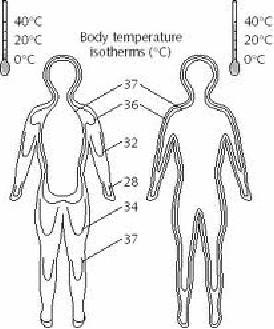The optimal temperature of the human body is 37 ̊ C approximately. If the surroundings are at a temperature of above 37 ̊ C then the body will absorb heat and needs to cool down by losing heat. Conversely, if the surroundings are below the optimal temperature, then the body will need to generate heat to regain the optimal temperature. A variation in the core temperature of 6 ̊C either side of this optimal temperature will result in death. As the body cools, isotherms of temperature retreat inwards (below left) but the core temperature remains at 37 ̊C for as long as possible. Compare this with the normal temperature distribution for the body (below right).

The main processes that result in the loss of thermal energy are convection, radiation, evaporation, respiration and expiration (breathing out).
Convection -depends on the temperature difference between the body and surroundings and the presence of a draught.
Radiation – depends on the absolute temperature of the body and it's surface area and clothing. About 100W for a naked person at 22 ̊C.
Evaporation – depends on the temperature difference between the body and surroundings, surface area of exposed skin, humidity and presence of a draught. About 20W in still air.
Expiration – carbon dioxide and water vapour and breathed out and carry heat energy away from the body About 20W in still air.
